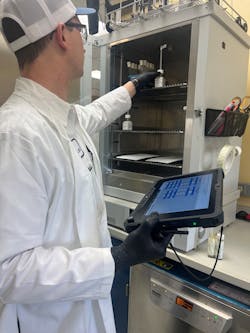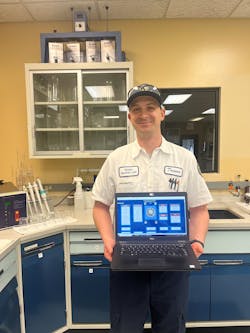San Luis Obispo water quality lab breaks down data silos and saves time by going digital
The City of San Luis Obispo, California treats about 1.75 billion gallons of water a year and serves around 47,545 customers with 14,800 metered connections. The city has three sources of water: Nacimiento Lake, Salinas Reservoir, and the Whale Rock Reservoir.
The city has a conventional surface water treatment process with an ozone contact basin and mixing tanks where aluminum sulfate and cationic polymer are added to remove small particles. The water is then filtered through anthracite and silicate sand until the water is clear and is then treated with chlorine and fluoride, and a corrosion inhibitor is added. To ensure this process runs smoothly and that residents receive the highest quality of drinking water, the city has its own water quality testing lab.
The city’s lab also provides process control and regulatory analysis of wastewater treatment at the Water Resource Recovery Facility (WRRF), which treats over 3.0 million gallons of wastewater a day.
The WRRF has stringent discharge requirements and produces effluent that meets Title 22 recycled water requirements. The effluent supports sensitive species, such as steelhead trout, in San Luis Obispo Creek. Some of this effluent is used to irrigate parks, median strips, and other landscaping.
Tanner Duncan, a water quality analyst for the City of San Luis Obispo, was instrumental in moving the lab away from physical logbooks and bench sheets by creating custom digital bench sheets in WIMS. The lab has configured a handful of laptops to make it easy to enter data throughout the different sampling and analysis stations.
“We are working toward making WIMS our one water platform for the city. This includes water treatment, wastewater, and water resources,” said Duncan.
Instant access to data reduces response times for process control
Duncan has used the custom-designed dashboard to add a box for lab analysts to initial when entering data, as sometimes one person will log in to a computer, and then another technician may come and enter a different measurement at the same computer.
“Traceability and trackability are very important in our lab analysis as we adhere to the laboratory accreditation standard, based on the ISO/IEC 17025 from TNI (the NELAC Institute), also known as National Environmental Laboratory Accreditation Conference. Any edits to sheets are automatically time-stamped,” said Duncan. “Having the ability to add custom features like this based on work habits at any point in time is helpful. There will always be new things we need to add, change, or maybe we will find a better way to do something. WIMS gives us this flexibility.”
The software also allows for parameter limits to be set for any variable so, if a test result is out of a defined limit range, it will immediately turn the cell a different color, indicating an action needs to be taken. If it falls outside a regulatory permit level, then it triggers a more critical warning, which results in different protocols for corrective action.
On an average day, the lab does 10-15 tests for operations that include pH and chlorine levels, temperature, ammonia, nitrates, nitrites, total suspended solids (TSS), chemical oxygen demand (COD), and biological oxygen demand (BOD). Lab analysts take samples throughout the city to test for THMs (Trihalomethanes), Total Coliforms, E. coli, chlorine, and fluoride. They also receive plant final effluent samples and recycled water samples, which are analyzed for total and fecal coliforms.
As the data is entered directly into WIMS, divisions within the Utilities Department have instant access to the information. If there is an issue, they will be notified immediately, enabling timely process adjustment when needed.
“Before WIMS, we would submit our data to operations by 3 p.m.; now, they get the results by 9 a.m. That’s how big of a time-saving the software has given us,” said Duncan.
Streamlining regulatory reporting
Once a variable or sample result is entered into WIMS, it will automatically populate on other sheets that have that same variable. This is particularly helpful and time-saving for regulatory reporting that requires more granular information.
WIMS has a wizard for building a bench sheet that calculates TSS, but regulatory reporting requires metadata, which is all the information in between.
Having all this data stored and accessible in one place significantly reduces the time for reporting National Pollutant Discharge Elimination System permits to California’s Integrated Water Quality System (CIWQS). Duncan enters all the data in WIMS and submits reports on the CIWQS website.
“When it comes to CIWQS we need to be able to show every step of the way to get to the TSS calculation, including the weight of the filter and the weight of the filter plus a sample. So, we created a monthly data sheet for all variables and went from 50 data points to 5-800 variables in order to capture the whole picture,” said Duncan. “By eliminating the redundancy of data entry, we have reduced the amount of time it takes to complete regulatory reports.”
Once a week, the lab dedicates a day to regulatory testing and analysis as required for NPDES permit compliance. The monthly data form is also used for trend analysis.
The city works closely with the State Water Resource Control Board and the Environmental Laboratory Accreditation Program to ensure it meets regulations and continues to invest in new treatment technologies and systems upgrades. Finding ways to streamline processes helps the city to keep up with new regulations and address other pressing issues. The City of San Luis Obispo is committed to customer outreach and education to ensure residents have safe, clean drinking water for generations to come. WW
About the Author
Erik Larsen
Erik is a digital solutions expert with a special focus on AI & machine learning, data & analytics, and managed services.


